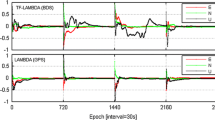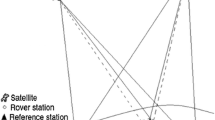Abstract
The effect of DD ionospheric delays can be unexpectedly large in the range of the equatorial anomaly, that is, in mid-low-latitude regions near noon and/or afternoon, and the large delays cause instantaneous AR to fail even over short baselines. Ionospheric delays can be represented by a function of vertical total electron content values, which often have significant latitudinal gradients in mid-low-latitude regions near noon and/or afternoon. Therefore, a short separation between the pivot and secondary satellites in the latitudinal direction indicates smaller effects of DD ionosphere. In the BeiDou system (BDS), five geostationary earth orbit (GEO) satellites are nearly motionless over the equator. We can use adjacent GEO satellites to form a DD pair whose pivot and secondary satellites are close in latitude (< 4°). Moreover, when inclined geosynchronous orbit or medium earth orbit (IGSO/MEO) satellites approach the equator, the separations between the IGSO/MEO and GEO satellites in the latitudinal direction will be minimal. Therefore, this study proposes a method called GEO-pivoted carrier AR (GEOCAR) for instantaneous AR. This method mitigates the influence of DD ionospheric delays by pivoting GEO satellites in BDS DD pairs and uses a trade-off design between the ionosphere-fixed and ionosphere-weighting models to resolve integer ambiguities of dual-frequency phases. Experimental short-baseline data (< 10 km) collected in mid-low-latitude regions near noon and afternoon are tested with conventional AR and GEOCAR methods. The results show that the GEOCAR can effectively produce higher success percentages than the conventional AR with improvements reaching 68.62% for BDS and 42.55% for BDS/GPS.















Similar content being viewed by others
References
Abdukkah M, Strangeways HJ, Walsh DMA (2007) Effects of ionospheric horizontal gradients on differential GPS. Acta Geophys 55(4):509–523
Anderson DN (1973) A theoretical study of the ionospheric F region equatorial anomaly—II. Results in the American and Asian sectors. Planet Space Sci 21(3):421–442
Cander LR, Mihajlovic SJ (2005) Ionospheric spatial and temporal variations during the 29–31 October 2003 storm. J Atmos Solar Terr Phys 67(12):1118–1128
Chen H-C, Huang Y-S, Chiang K-W, Yang M, Rau R-J (2009) The performance comparison between GPS and BeiDou-2/COMPASS: a perspective from Asia. J Chin Inst Eng 32(5):679–689
Chen J, Yue D, Zhu S, Chen H, Liu Z, Zhao X (2018) Correction model of BDS satellite-induced code bias and its impact on precise point positioning. Adv Space Res 63(7):2155–2163
Chu F-Y, Yang M (2014) GPS/Galileo long baseline computation: method and performance analyses. GPS Solut 18(2):263–272
Chu F-Y, Yang M (2018) BeiDou system (BDS) triple-frequency ambiguity resolution without code measurements. Remote Sens 10(5):675
Chu F-Y, Yang M, Wu J (2014) Triple-frequency GPS ambiguity resolution for postprocessed medium-range baseline determination: a phase-only method. J Chin Inst Eng 37(3):279–287
Chu F-Y, Yang M, Wu J (2016) A new approach to modernized GPS phase-only ambiguity resolution over long baselines. J Geod 90(3):241–254
CSNO (2013) BeiDou navigation satellite system signal in space interface control document: open service signal, version 2.0. China satellite navigation office, Dec 2013. Available on the internet
Goad CC, Goodman L A (1974) Modified hopfield tropospheric refraction correction model. In: American geophysical union fall meeting. San Francisco, December 12–17, pp 1106–1133
Hofmann-Wellenhof B, Lichtenegger H, Wasle E (2008) GNSS-global navigation satellite systems. Springer, Vienna
Kakoti G, Bhuyan PK, Hazarika R (2017) Seasonal and solar cycle effects on TEC at 95°E in the ascending half (2009–2014) of the subdued solar cycle 24: consistent underestimation by IRI 2012. Adv Space Res 60(2):257–275
Klobuchar JA (1987) Ionospheric time-delay algorithm for single-frequency GPS users. IEEE Trans Aerosp Electron Syst AES-23(3):325–331
Kunitsyn VE, Padokhin AM, Kurbatov GA, Yasyukevich YV, Morozov YV (2016) Ionospheric TEC estimation with the signals of various geostationary navigational satellites. GPS Solut 20(4):877–884
Leick A, Rapoport L, Tatarnikov D (2015) GPS satellite surveying, 4th edn. Wiley, New York
Lejeune S, Warnant R (2008) A novel method for the quantitative assessment of the ionosphere effect on high accuracy GNSS applications, which require ambiguity resolution. J Atmos Solar Terr Phys 70(6):889–900
Li B, Verhagen S, Teunissen PJG (2014) Robustness of GNSS integer ambiguity resolution in the presence of atmospheric biases. GPS Solut 18(2):283–296
Misra P, Enge P (2006) Global positioning system, signal, measurements, and performance, 2nd edn. Ganag-Jamuna Press, Lincoln
Montenbruck O, Hauschild A, Steigenberger P, Hugentobler U, Teunissen P, Nakamura S (2013) Initial assessment of the COMPASS/BeiDou-2 regional navigation satellite system. GPS Solut 17(2):211–222
Muhtarov P, Kutiev I (1999) Autocorrelation method for temporal interpolation and short-term prediction of ionospheric data. Radio Sci 34(2):459–464
Nadarajah N, Teunissen PJG, Sleewaegen J-M, Montenbruck O (2015) The mixed-receiver BeiDou inter-satellite-type bias and its impact on RTK positioning. GPS Solut 19(3):357–368
Odijk D, HvD Marel, Song I (2000) Precise GPS positioning by applying ionospheric corrections from an active control network. GPS Solut 3(3):49–57
Parkins A (2010) Increasing GNSS RTK availability with a new single-epoch batch partial ambiguity resolution algorithm. GPS Solut 15(4):391–402
Rishbeth H, Mendillo M (2001) Patterns of F2-layer variability. J Atmos Solar Terr Phys 63(15):1661–1680
Strangeways HJ (2000) Effect of horizontal gradients on ionospherically reflected or transionospheric paths using a precise homing-in method. J Atmos Solar Terr Phys 62(15):1361–1376
Tang W, Deng C, Shi C, Liu J (2014) Triple-frequency carrier ambiguity resolution for Beidou navigation satellite system. GPS Solut 18(3):335–344
Teunissen PJG (1995) The least-squares ambiguity decorrelation adjustment: a method for fast GPS integer ambiguity estimation. J Geod 70:65–82
Teunissen PJG (1998) Success probability of integer GPS ambiguity rounding and bootstrapping. J Geod 72(1–2):606–612
Verhagen S (2004) Integer ambiguity validation: an open problem? GPS Solut 8(1):36–43
Verhagen S, Teunissen PJG (2013) The ratio test for future GNSS ambiguity resolution. GPS Solut 17(4):535–548
Wielgosz P, Kashani I, Grejner-Brzezinska D (2005) Analysis of long-range network RTK during a severe ionospheric storm. J Geod 79(9):524–531
Wu X, Hu X, Wang G, Zhong H, Tang C (2014) Evaluation of COMPASS ionospheric model in GNSS positioning. Adv Space Res 51(6):959–968
Yang M, Tang C-H, Yu T-T (2000) Development and assessment of a medium-range real-time kinematic GPS algorithm using an ionospheric information filter. Earth, Planets Space 52(10):783–788
Yang M, Chu F-Y, Lin C-Y (2018) GNSS ambiguity resolution in kinematic positioning: benefits of satellite availability and sampling rate. J Aeronaut Astron Aviat 50(2):187–204
Yoshihara T, Saito A (2004) A study of the ionospheric effect on GBAS (Ground-Based Augmentation System) using the nation-wide GPS network data in Japan. In: ION NTM 2004. Institute of Navigation, San Diego, January 26–28, pp 502–511
Zhang X, He X, Liu W (2017) Characteristics of systematic errors in the BDS Hatch–Melbourne–Wübbena combination and its influence on wide-lane ambiguity resolution. GPS Solut 21(1):265–277
Acknowledgments
This work is supported by the Ministry of Science and Technology (Grant Nos. 107-2219-M-006-025 and 107-2221-E-006-123-MY3) of Taiwan.
Author information
Authors and Affiliations
Corresponding author
Additional information
Publisher's Note
Springer Nature remains neutral with regard to jurisdictional claims in published maps and institutional affiliations.
Rights and permissions
About this article
Cite this article
Chu, FY., Yang, M. & Chen, YT. GEO-pivoted carrier ambiguity resolution: a method for instantaneous ambiguity resolution in mid-low-latitude regions. GPS Solut 23, 107 (2019). https://doi.org/10.1007/s10291-019-0884-5
Received:
Accepted:
Published:
DOI: https://doi.org/10.1007/s10291-019-0884-5




